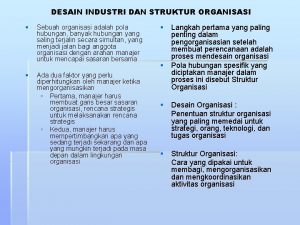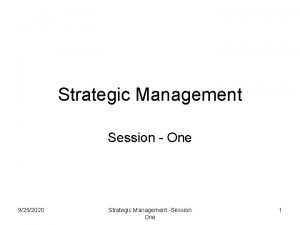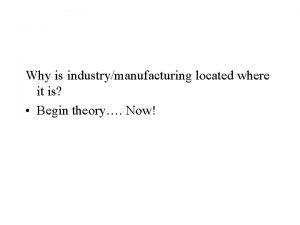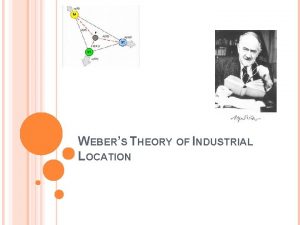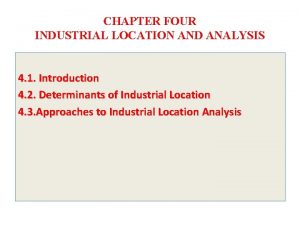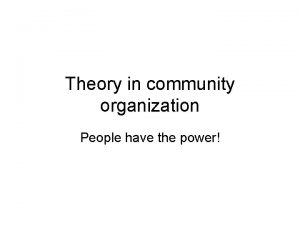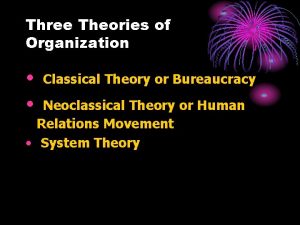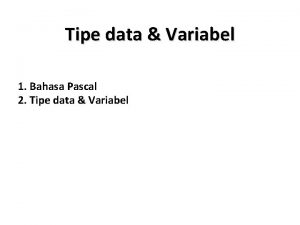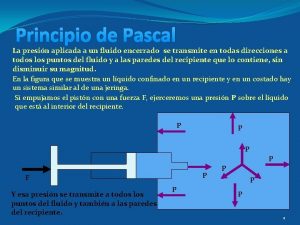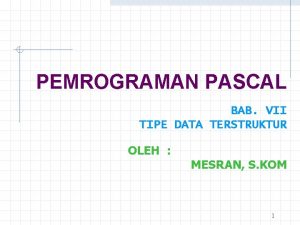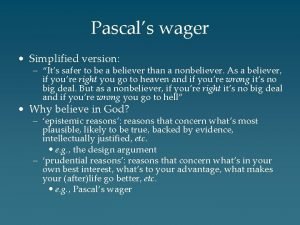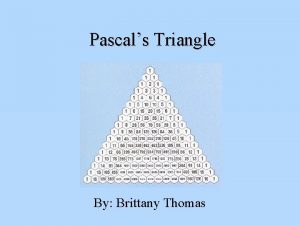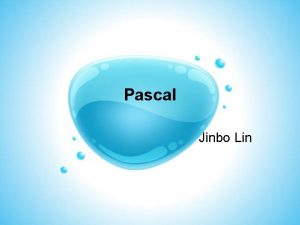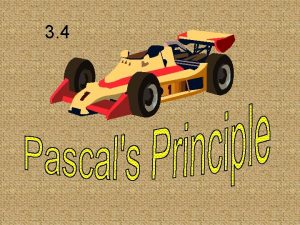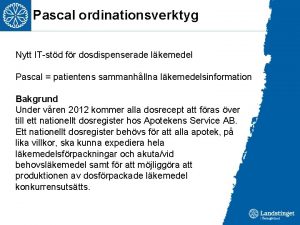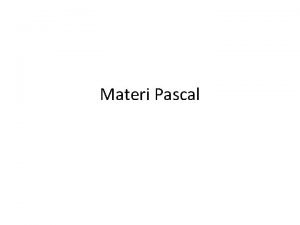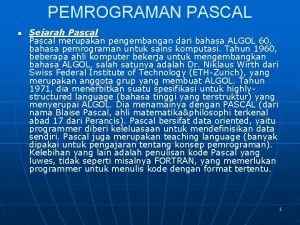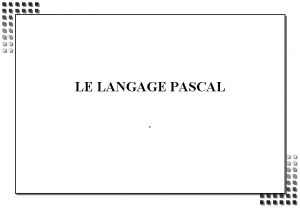Industrial Organization IO Pascal Courty Industrial Organization Theory



































- Slides: 35

Industrial Organization (IO) Pascal Courty

Industrial Organization: Theory and Practice • • • Practitioners’ issues and debates Competition policy (should government interfere with firm management and market conduct? ) • Firm strategies (How to sustain competitive advantage and earn positive economic profits? ) Academia Theory of firm behavior and market conduct (set of abstractions, frameworks, and formal models) Focus on specific mechanisms that capture important and general principles Theory Meets Practice • Empirical research on specific markets • Policy recommendations (to government agency or firm manager) Paul Belleflamme and Martin Peitz. © Cambridge University Press 2009, Adapted by Pascal Courty 2010

Introduction to Part I Markets • Play a central role in the allocation of goods • Affect production decisions Goal of “Markets and Strategies” • Present the role of imperfectly competitive markets for private and social decisions Issues related to markets and strategies • Extremely large array! • Firms take thousands of strategic decisions • . . reacting to particular market conditions • . . and affecting the well-being of market participants. Paul Belleflamme and Martin Peitz. © Cambridge University Press 2009, Adapted by Pascal Courty 2010

Part II. Market power Chapter 3. Static imperfect competition Slides Industrial Organization: Markets and Strategies Paul Belleflamme and Martin Peitz. © Cambridge University Press 2009, Adapted by Pascal Courty 2010

Introduction to Part II Oligopolies • Industries in which a few firms compete • Market power is collectively shared. • Firms can’t ignore their competitors’ behaviour. • Strategic interaction Game theory Oligopoly theories • Cournot (1838) quantity competition • Bertrand (1883) price competition • Not competing but complementary theories • Relevant for different industries or circumstances Paul Belleflamme and Martin Peitz. © Cambridge University Press 2009, Adapted by Pascal Courty 2010

Introduction to Part II Organization of Part II • Chapter 3 • Simple settings: unique decision at single point in time • How does the nature of strategic variable (price or quantity) affect • strategic interaction? • extent of market power? • Chapter 4 • Incorporates time dimension: sequential decisions • Effects on strategic interaction? • What happens before and after strategic interaction takes place? Paul Belleflamme and Martin Peitz. © Cambridge University Press 2009, Adapted by Pascal Courty 2010

Introduction to Part II Case. DVD-by-mail industry • Facts • < 2004: Netflix almost only active firm • 2004: entry by Wal-Mart and Blockbuster (and later Amazon), not correctly foreseen by Netflix • Sequential decisions • Leader: Netflix • Followers: Wal-Mart, Blockbuster, Amazon • Price competition • Wal-Mart and Blockbuster undercut Netflix • Netflix reacts by reducing its prices too. • Quantity competition? • Need to store more copies of latest movies Paul Belleflamme and Martin Peitz. © Cambridge University Press 2009, Adapted by Pascal Courty 2010

Chapter 3 - Objectives Chapter 3. Learning objectives • Get (re)acquainted with basic models of oligopoly theory • Price competition: Bertrand model • Quantity competition: Cournot model • Be able to compare the two models • Quantity competition may be mimicked by a two-stage model (capacity-then-price competition) • Unified model to analyze price & quantity competition • Understand the notions of strategic complements and strategic substitutes • See how to measure market power empirically Paul Belleflamme and Martin Peitz. © Cambridge University Press 2009, Adapted by Pascal Courty 2010

Chapter 3 - Price competition The standard Bertrand model • 2 firms • Homogeneous products • Identical constant marginal cost: c • Set price simultaneously to maximize profits • Consumers • Firm with lower price attracts all demand, Q(p) • At equal prices, market splits at 1 and 2 1 1 • Firm i faces demand Paul Belleflamme and Martin Peitz. © Cambridge University Press 2009, Adapted by Pascal Courty 2010

Chapter 3 - Price competition The standard Bertrand model (cont’d) • Unique Nash equilibrium • Both firms set price = marginal cost: p 1 p 2 c • Proof • For any other (p 1, p 2), a profitable deviation exists. • Or: unique intersection of firms’ best-response functions Paul Belleflamme and Martin Peitz. © Cambridge University Press 2009, Adapted by Pascal Courty 2010

Chapter 3 - Price competition The standard Bertrand model (cont’d) • ‘Bertrand Paradox’ • Only 2 firms but perfectly competitive outcome • Message: there exist circumstances under which duopoly competitive pressure can be very strong • Lesson: In a homogeneous product Bertrand duopoly with identical and constant marginal costs, the equilibrium is such that • firms set price equal to marginal costs; • firms do not enjoy any market power. • Cost asymmetries • n firms, ci • Equilibrium: any price Paul Belleflamme and Martin Peitz. © Cambridge University Press 2009, Adapted by Pascal Courty 2010

Chapter 3 - Price competition Bertrand competition with uncertain costs • Each firm has private information about its costs • Trade-off between margins and likelihood of winning the competition • Lesson: In the price competition model with homogeneous products and private information about marginal costs, at equilibrium, • firms set price above marginal costs; • firms make strictly positive expected profits; • more firms price-cost margins , output , profits ; • Infinite number of firms competitive limit. Paul Belleflamme and Martin Peitz. © Cambridge University Press 2009, Adapted by Pascal Courty 2010

Chapter 3 - Price competition with differentiated products • Firms may avoid intense competition by offering products that are imperfect substitutes. • Hotelling model (1929) Disutility from travelling 0 1 Firm 2 Mass 1 of consumers, uniformly distributed Paul Belleflamme and Martin Peitz. © Cambridge University Press 2009, Adapted by Pascal Courty 2010

Chapter 3 - Price competition Hotelling model (cont’d) • Suppose location at the extreme points 0 Firm 1 1 Indifferent consumer Paul Belleflamme and Martin Peitz. © Cambridge University Press 2009, Adapted by Pascal Courty 2010 Firm 2

Chapter 3 - Price competition Hotelling model (cont’d) • Resolution • Firm’s problem: • From FOC, best-response function: • Equilibrium prices: • Lesson: If products are more differentiated, firms enjoy more market power. • Extensions • Localized competition with n firms: Salop (circle) model • Asymmetric competition with differentiated products Paul Belleflamme and Martin Peitz. © Cambridge University Press 2009, Adapted by Pascal Courty 2010

Chapter 3 - Quantity competition The linear Cournot model • Model • Homogeneous product market with n firms • Firm i sets quantity qi • Total output: q q 1 q 2 . . . qn • Market price given by P(q) a bq • Linear cost functions: Ci(qi) ci qi • Notation: q-i q qi • Residual demand Paul Belleflamme and Martin Peitz. © Cambridge University Press 2009, Adapted by Pascal Courty 2010

Chapter 3 - Quantity competition The linear Cournot model (cont’d) • Firm’s problem • Cournot conjecture: conjecture rivals don’t modify their quantity • Firm i acts as a monopolist on its residual demand: • FOC: • Best-response function: • Nash equilibrium in the duopoly case • Assume: • Then, Paul Belleflamme and Martin Peitz. © Cambridge University Press 2009, Adapted by Pascal Courty 2010

Chapter 3 - Quantity competition The linear Cournot model (cont’d) • Duopoly • Lesson: In the linear Cournot model with homogeneous products, a firm’s equilibrium profits increases when the firm becomes relatively more efficient than its rivals. Paul Belleflamme and Martin Peitz. © Cambridge University Press 2009, Adapted by Pascal Courty 2010

Chapter 3 - Quantity competition Symmetric Cournot oligopoly • Assume • Then • If n individual quantity , total quantity , market price , markup • If n , then markup 0 • Lesson: The (symmetric linear) Cournot model converges to perfect competition as the number of firms increases. Paul Belleflamme and Martin Peitz. © Cambridge University Press 2009, Adapted by Pascal Courty 2010

Chapter 3 - Quantity competition Implications of Cournot competition • General demand cost functions • Cournot pricing formula • Lesson: In the Cournot model, the markup of firm i is larger the larger is the market share of firm i and the less elastic is market demand. • If constant marginal costs Average Lerner index Paul Belleflamme and Martin Peitz. © Cambridge University Press 2009, Adapted by Pascal Courty 2010

Chapter 3 - Price vs. quantity Price versus quantity competition • Comparison of previous results • Let Q(p) a p, c 1 c 2 c • Bertrand: p 1 p 2 c, q 1 q 2 (a c)/2, 1 2 • Cournot: q 1 q 2 (a c)/3, p (a 2 c)/3, 1 2 (a c)2/9 • Lesson: Homogeneous product case higher price, lower quantity, higher profits under quantity than under price competition. • To refine the comparison • Limited capacities of production • Direct comparison within a unified model • Identify characteristics of price or quantity competition Paul Belleflamme and Martin Peitz. © Cambridge University Press 2009, Adapted by Pascal Courty 2010

Chapter 3 - Price vs. quantity Limited capacity and price competition • Edgeworth’s critique (1897) • Bertrand model: no capacity constraint • But capacity may be limited in the short run. • Examples • Retailers order supplies well in advance • DVD-by-mail industry • Larger demand for latest movies need to hold extra stock of copies higher costs and stock may well be insufficient • Flights more expensive around Xmas • To account for this: two-stage model 1. Firms precommit to capacity of production 2. Price competition Paul Belleflamme and Martin Peitz. © Cambridge University Press 2009, Adapted by Pascal Courty 2010

Chapter 3 - Price vs. quantity Capacity-then-price model (Kreps & Scheinkman) • Setting • Stage 1: 1 firms set capacities and incur cost of capacity, c • Stage 2: 2 firms set prices pi; cost of production is up to capacity (and infinite beyond capacity); demand is Q(p) a p. • Subgame-perfect equilibrium: equilibrium firms know that capacity choices may affect equilibrium prices • Rationing • If quantity demanded to firm i exceeds its supply. . . • . . . some consumers have to be rationed. . . • . . . and possibly buy from more expensive firm j. • Crucial question: question Who will be served at the low price? Paul Belleflamme and Martin Peitz. © Cambridge University Press 2009, Adapted by Pascal Courty 2010

Chapter 3 - Price vs. quantity Capacity-then-price model (cont’d) • Efficient rationing • First served: consumers with higher willingness to pay. • Justification: queuing system, secondary markets Consumers with unit demand, ranked by decreasing willingness to pay There is a positive residual demand for firm 2 Consumers with highest willingness to pay are served at firm 1’s low price Excess demand for firm 1 Paul Belleflamme and Martin Peitz. © Cambridge University Press 2009, Adapted by Pascal Courty 2010

Chapter 3 - Price vs. quantity Capacity-then-price model (cont’d) • Equilibrium (sketch) • Stage 2. If p 1 < p 2 and excess demand for firm 1, then demand for 2 is: Claim: if c a (4/3)c, then both firms set the marketclearing price: • Stage 1. Same reduced profit functions as in Cournot: • Lesson: In the capacity-then-price game with efficient consumer rationing (and with linear demand constant marginal costs), the chosen capacities are equal to those in a standard Cournot market. Paul Belleflamme and Martin Peitz. © Cambridge University Press 2009, Adapted by Pascal Courty 2010

Chapter 3 - Price vs. quantity Differentiated products: Cournot vs. Bertrand • Setting • Duopoly, diffentiated products (b d, b>0) • Consumers maximize linear-quadratic utility function under budget constraint • Inverse demand functions • Demand functions Paul Belleflamme and Martin Peitz. © Cambridge University Press 2009, Adapted by Pascal Courty 2010

Chapter 3 - Price vs. quantity Differentiated products (cont’d) • Maximization program • Cournot: • Bertrand: • Best-response functions • Cournot: Downward-sloping Strategic substitutes • Bertrand: Upward-sloping Strategic complements • Comparison of equilibria • Lesson: Price as the strategic variable gives rise to a more competitive outcome than quantity as the strategic variable. Paul Belleflamme and Martin Peitz. © Cambridge University Press 2009, Adapted by Pascal Courty 2010

Chapter 3 - Price vs. quantity Appropriate modelling choice: price or quantity? • Monopoly: Monopoly it doesn’t matter. • Oligopoly: Oligopoly price and quantity competitions lead to different residual demands • Price competition • pj fixed rival willing to serve any demand at pj • i’s residual demand: market demand at pi pj; zero at pi pj • So, residual demand is very sensitive to price changes. • Quantity competition • qj fixed irrespective of price obtained, rival sells qj • i’s residual demand: “what’s left” (i. e. , market demand qj) • So, residual demand is less sensitive to price changes. Paul Belleflamme and Martin Peitz. © Cambridge University Press 2009, Adapted by Pascal Courty 2010

Chapter 3 - Price vs. quantity Appropriate modelling choice (cont’d) • How do firms behave in the market place? • Stick to a price and sell any quantity at this price? price competition appropriate choice when • Unlimited capacity • Prices more difficult to adjust in the short run than quantities • Example: mail-order business • Stick to a quantity and sell this quantity at any price? quantity competition appropriate choice when • Limited capacity (even if firms are price-setters) • Quantities more difficult to adjust in the short run than prices • Example: package holiday industry • Influence of technology (e. g. Print-on-demand vs. batch printing) Paul Belleflamme and Martin Peitz. © Cambridge University Press 2009, Adapted by Pascal Courty 2010

Chapter 3 - Price vs. quantity Strategic substitutes and complements • How does a firm react to the rivals’ actions? • Look at the slope of reaction functions. • Upward sloping: competitor its action marginal profitability of my own action variables are strategic complements • Example: price competition (with substitutable products); See Bertrand Hotelling models • Downward sloping: competitor its action marginal profitability of my own action variables are strategic substitutes • Example: quantity competition (with substitutable products); see Cournot model Paul Belleflamme and Martin Peitz. © Cambridge University Press 2009, Adapted by Pascal Courty 2010

Chapter 3 - Price vs. quantity Strategic substitutes and complements (cont’d) • Linear demand model of product differentiation (with d measuring the degree of product substitutability) Paul Belleflamme and Martin Peitz. © Cambridge University Press 2009, Adapted by Pascal Courty 2010

Chapter 3 - Estimating market power • Setting • Symmetric firms producing homogeneous product • Demand equation: p P(q, x) (1) • q: total quantity in the market • x: vector of exogenous variables affecting demand (not cost) • Marginal costs: c(q, w) • w: vector of exogenous variables affecting (variable) costs • Approach 1. Nest various market structures in a single model Firm’s conjecture as to how strongly price reacts to its change in output Paul Belleflamme and Martin Peitz. © Cambridge University Press 2009, Adapted by Pascal Courty 2010

Chapter 3 - Estimating market power (cont’d) • Approach 1 (cont’d) • Basic model to be estimated non-parametrically: demand equation (1) + equilibrium condition (2) • Approach 2. Be agnostic about precise game being played • From equilibrium condition (2), Lerner index is • (2) is identified if single c(q, w) and single satisfy it Paul Belleflamme and Martin Peitz. © Cambridge University Press 2009, Adapted by Pascal Courty 2010

Chapter 3 - Review questions • How does product differentiation relax price competition? Illustrate with examples. • How does the number of firms in the industry affect the equilibrium of quantity competition? • When firms choose first their capacity of production and next, the price of their product, this two-stage competition sometimes looks like (one-stage) Cournot competition. Under which conditions? • Using a unified model of horizontal product differentiation, one comes to the conclusion that price competition is fiercer than quantity competition. Explain the intuition behind this result. Paul Belleflamme and Martin Peitz. © Cambridge University Press 2009, Adapted by Pascal Courty 2010

Chapter 3 - Review questions (cont’d) • Define the concepts of strategic complements and strategic substitutes. Illustrate with examples. • What characteristics of a specific industry will you look for to determine whether this industry is better represented by price competition or by quantity competition? Discuss. Paul Belleflamme and Martin Peitz. © Cambridge University Press 2009, Adapted by Pascal Courty 2010
 Bernard courty
Bernard courty Industrial design organization
Industrial design organization Resource based model
Resource based model Strategic competitiveness
Strategic competitiveness Process organization in computer organization
Process organization in computer organization Compare and contrast organization
Compare and contrast organization Least cost theory
Least cost theory Isodapane in the theory of industrial location
Isodapane in the theory of industrial location Alfred webers theory
Alfred webers theory Tord palander theory of industrial location
Tord palander theory of industrial location Theory of industrial relations
Theory of industrial relations Organizational environmental theory
Organizational environmental theory Difference between classical theory and neoclassical theory
Difference between classical theory and neoclassical theory Community organization theory
Community organization theory Levels of biological organization
Levels of biological organization Classical theory of organization
Classical theory of organization Power and politics organization theory
Power and politics organization theory Organization theory
Organization theory Pascal felber
Pascal felber Blaise pascal university
Blaise pascal university Chady salloum
Chady salloum Tipe data pada bahasa pascal adalah
Tipe data pada bahasa pascal adalah Principio di pascal fisica
Principio di pascal fisica Pisanje programa
Pisanje programa Principio de pascal
Principio de pascal Aplicaciones del principio de pascal
Aplicaciones del principio de pascal Se desea levantar un automóvil de masa
Se desea levantar un automóvil de masa Materi perulangan pascal while do
Materi perulangan pascal while do Jelaskan tipe data sederhana dan terstruktur
Jelaskan tipe data sederhana dan terstruktur Pascal's wager simplified
Pascal's wager simplified Pascal's triangle
Pascal's triangle History of pascal's triangle
History of pascal's triangle Fyzik pascal
Fyzik pascal Shortint pascal
Shortint pascal Pascal prensibi
Pascal prensibi Graph pascal
Graph pascal

